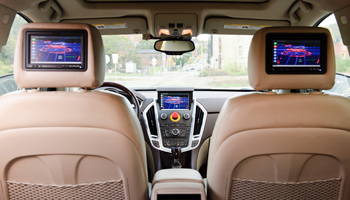The vehicle looks, from the outside, much like any other 2011 Cadillac SRX. It is not. It is a self-driving car, developed by the Carnegie Mellon University, that negotiated congestion and highway traffic while safely changing lanes and merging during a 33-mile drive from Cranberry, Pa., to Pittsburgh International Airport, as part of a demonstration.
A human was in the driver’s seat as a safety precaution, but all of the driving was done by Carnegie Mellon’s innovative software, relying on inputs from radars, lidars and infrared cameras.
U.S. Rep. Bill Shuster (R-Pa), chairman of the House Transportation and Infrastructure Committee, and Barry Schoch, secretary of the Pennsylvania Department of Transportation, were along for the ride in the autonomous car.
Unlike previous self-driving vehicles, including Boss, the autonomous Chevy Tahoe with which CMU won the 2007 DARPA Urban Challenge, the SRX doesn’t bristle with exotic and expensive sensors, says the university. The vehicle uses only automotive-grade radars and lidars, which are unobtrusively embedded around the car. Its computers are hidden under the cargo floor.
In addition to controlling the steering, speed and braking, the autonomous systems also detect and avoid obstacles in the road, including traffic cones and barrels, as well as pedestrians and bicyclists, pausing until they are safely out of the way. The systems provide audible warnings of obstacles and communicate vehicle status to its passengers using a human-like voice.
This Cadillac SRX can also communicate with instrumented traffic lights and other vehicles equipped with wireless communication devices to enable cooperation.
Self-driving vehicles will begin to be commercially available around 2020 as near-term costs as well as social and legal concerns are addressed, says Raj Rajkumar, who directs CMU’s U.S. Department of Transportation-funded transportation research center and co-directs the CMU-General Motors Autonomous Driving Collaborative Research Lab.
CMU’s portfolio of transportation technology projects includes the Traffic21 initiative, launched with the support of the Hillman Foundation and the Technologies for Safe and Efficient Transportation Center, a U.S. Department of Transportation University Transportation Center at Carnegie Mellon in partnership with the University of Pennsylvania that also received support from the Hillman Foundation.
[Image courtesy: Carnegie Mellon University]
You may also be interested in:


